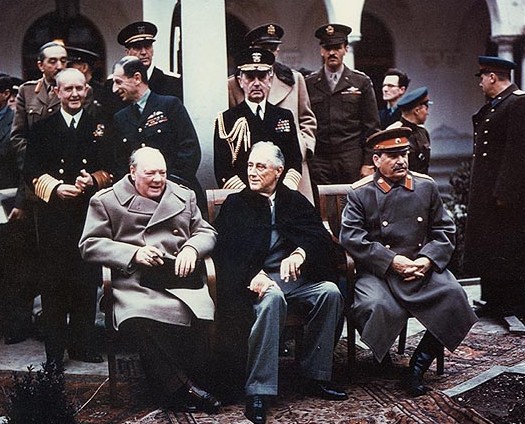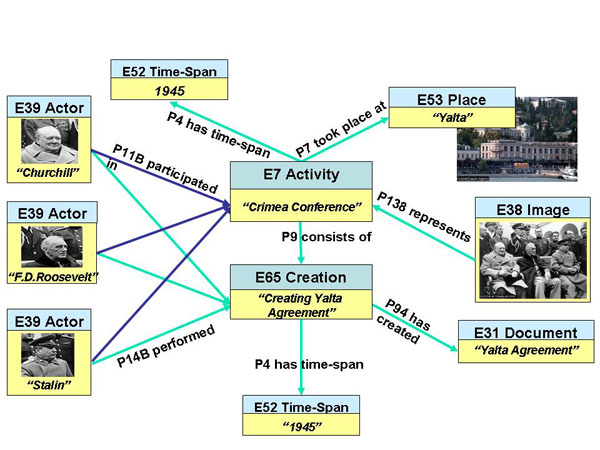CIDOC CRM Core Demonstration Martin Doerr, ISC-FORTH, martin@ics.forth.gr Dolores Iorizzo, ICSTM, London, UK d.iorizzo@imperial.ac.uk
Patrick Sinclair
, Paul Lewis, Kirk 2006-01-16 |
The CRM Core is a recent proposal of CIDOC for a highly condensed set of metadata elements which basically reduces the CIDOC CRM to the above principles and still is ISO21127 compatible. It is Dublin Core compatible, but more than Dublin Core, it can be used to describe large meaningful networks of knowledge which allow for querying meaningful deep data paths of properties, such as “the organizations X with which partners of contract Y had already contracts before”. The design of CRM Core is so that it enables the construction of networks, as the Hoagland example in Appendix A demonstrates. This is a novel requirement to metadata elements, previously seen just as finding aids, but not as means to relate information. Of course, one can produce a multitude of such metadata structures from the CIDOC CRM, at different levels of sophistication. The CRM Core is an extraordinary simple one. These days, many researchers concentrate on ontologies used as categorical data, i.e. formally defined terminological systems of individual concepts, rather than relationships. They often oversee the completely different character of core ontologies describing schema semantics. The latter are the ones employed in the database integration experiments in the nineties, such as TSIMMIS, Infosleuth etc. They are small and dominated by relationships. It is often argued, that IsA hierarchies of a domain terminology “structure” a domain. This might be, but they do not structure information itself. The internal structure of information units is given by relations (or attributes) connecting particulars, and not by individual classes or terms. If information units are integrated, again it is the relationships that provide structure. In conceptual models, classes mainly govern the consistent application of the relationships. Classification of information does not integrate information in the narrower sense. It aggregates it and divides it up. It cannot describe any complementary information. The CRM Core as an XML DTD is provided in Appendix A to illustrate the basic idea of the CIDOC CRM. We will use the examples of information modelled in CRM Core in the rest of the document. |
|
The following examples are an implementation of a specific part of the structure of CRM Core dtd . See the graphical representation below. |
 |
Annotation
The Sphinx scenario described in the introduction illustrates the complexity of the information modelling problem in the cultural heritage domain. Through the examples in this section we demonstrate the requirements for cultural heritage annotation of multimedia objects, and how the CIDOC CRM supports these. |
A photo of an event – the Yalta Conference
 |
http://en.wikipedia.org/wiki/Image:Yalta_Conference.jpg Yalta summit 1945 with Churchill, Roosevelt, Stalin. Here is a more complex example involving a photo of Churchill, Roosevelt and Stalin at the Yalta Conference. Again, the subjects of the photo are modelled through a representation event with several participants. This event references a sub event of the Yalta Conference, the creation of the "Protocol of Proceedings of Crimea Conference" document (following page). |
 |
The image on Wikipedia:
<?xml version="1.0" encoding="UTF-8"?>
<!DOCTYPE CRM_Core SYSTEM "CRM_Core.dtd">
<!-- Example created by Patrick Sinclair -->
<CRM_Core>
<Category>E38 Image</Category>
<Classification name_space="http://www.getty.edu/research/conducting_research/vocabularies/aat/"
>photographs</Classification>
<Identification>http://en.wikipedia.org/wiki/Image:Yalta_Conference.jpg</Identification>
<Description>Yalta summit in 1945 with Winston Churchill, Franklin Roosevelt and Josef Stalin</Description>
<Event>
<Role_in_Event>P138 represents</Role_in_Event>
<Identification name_space="http://cidoc.ics.forth.gr/crm_core/demo">Crimea Conference</Identification>
<Event_Type name_space="http://cidoc.ics.forth.gr/rdfs/cidoc_v4.2.rdfs">E7_Activity</Event_Type>
<Participant>
<Identification name_space="http://en.wikipedia.org/wiki/Churchill">Churchill</Identification>
<Participant_Type name_space="http://www.getty.edu/research/conducting_research/vocabularies/aat/"
>politicians</Participant_Type>
</Participant>
<Participant>
<Identification name_space="http://en.wikipedia.org/wiki/Franklin_Delano_Roosevelt>Franklin Delano Roosevelt</Identification>
<Participant_Type name_space="http://www.getty.edu/research/conducting_research/vocabularies/aat/"
>politicians</Participant_Type>
</Participant>
<Participant>
<Identification name_space="http://en.wikipedia.org/wiki/Stalin>Stalin</Identification>
<Participant_Type name_space="http://www.getty.edu/research/conducting_research/vocabularies/aat/"
>politicians</Participant_Type>
</Participant>
<Date>1945</Date>
<Place name_space="http://www.getty.edu/research/conducting_research/vocabularies/tgn/">Yalta (inhabited place)</Place>
<RelatedEvent>
<Role_in_Event>P9 consists of</Role_in_Event>
<Identification name_space="http://cidoc.ics.forth.gr/crm_core/demo">Creating Yalta Agreement</Identification>
</RelatedEvent>
</Event>
</CRM_Core>
Record for the Protocol of Proceedings of Crimea Conference:
<?xml version="1.0" encoding="UTF-8"?>
<!DOCTYPE CRM_Core SYSTEM "CRM_Core.dtd">
<!-- Example created by Patrick Sinclair -->
<CRM_Core>
<Category>E31.Document</Category>
<Identification>http://www.taiwandocuments.org/yalta.htm</Identification>
<Description>Protocol of Proceedings of Crimea Conference.</Description>
<Event>
<Role_in_Event>P94B was created by</Role_in_Event>
<Identification name_space="http://cidoc.ics.forth.gr/crm_core/demo">Creating Yalta Agreement</Identification>
<Event_Type name_space="http://cidoc.ics.forth.gr/rdfs/cidoc_v4.2.rdfs">E65_Creation</Event_Type>
<Participant>
<Identification name_space="http://en.wikipedia.org/wiki/Churchill">Churchill</Identification>
<Participant_Type name_space="http://www.getty.edu/research/conducting_research/vocabularies/aat/"
>politicians</Participant_Type>
</Participant>
<Participant>
<Identification name_space="http://en.wikipedia.org/wiki/Franklin_Delano_Roosevelt>Franklin Delano Roosevelt</Identification>
<Participant_Type name_space="http://www.getty.edu/research/conducting_research/vocabularies/aat/"
>politicians</Participant_Type>
</Participant>
<Participant>
<Identification name_space="http://en.wikipedia.org/wiki/Stalin>Stalin</Identification>
<Participant_Type name_space="http://www.getty.edu/research/conducting_research/vocabularies/aat/"
>politicians</Participant_Type>
</Participant>
<Date>1945</Date>
<Place name_space="http://www.getty.edu/research/conducting_research/vocabularies/tgn/">Yalta (inhabited place)</Place>
<RelatedEvent>
<Role_in_Event>P9B forms part of</Role_in_Event>
<Identification name_space="http://cidoc.ics.forth.gr/crm_core/demo">Crimea Conference</Identification>
</RelatedEvent>
</Event>
</CRM_Core>